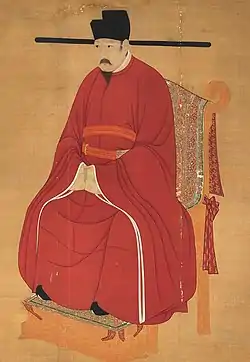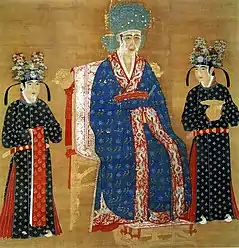Emperor Renzong of Song
Emperor Renzong of Song (30 May 1010 – 30 April 1063), personal name Zhao Zhen, was the fourth emperor of the Song dynasty of China. He reigned for about 41 years from 1022 to his death in 1063, and was the longest reigning Song dynasty emperor. He was the sixth son of his predecessor, Emperor Zhenzong, and was succeeded by his cousin's son, Zhao Shu who took the throne as Emperor Yingzong because his own sons died prematurely. His original personal name was Zhao Shouyi but it was changed by imperial decree in 1018 to "Zhao Zhen", which means 'auspicious' in Chinese.
| Emperor Renzong of Song 宋仁宗 | |||||||||||||
|---|---|---|---|---|---|---|---|---|---|---|---|---|---|
 | |||||||||||||
| Emperor of the Song dynasty | |||||||||||||
| Reign | 24 March 1022 – 30 April 1063 | ||||||||||||
| Coronation | 24 March 1022 | ||||||||||||
| Predecessor | Emperor Zhenzong | ||||||||||||
| Successor | Emperor Yingzong | ||||||||||||
| Regent | Empress Liu (1022 – 1033) | ||||||||||||
| Born | Zhao Shouyi (1010–1018) Zhao Zhen (1018–1063) 30 May 1010 (大中祥符三年四月十四日) | ||||||||||||
| Died | 30 April 1063 (aged 52) (嘉祐八年三月廿九日) Bianliang, Northern Song dynasty | ||||||||||||
| Burial | Yongzhao Mausoleum (永昭陵, in present-day Gongyi, Henan) | ||||||||||||
| Consorts | |||||||||||||
| Issue | Princess Zhuangxiao Princess Lingde Princess Xianyi Princess Yimu | ||||||||||||
| |||||||||||||
| House | Zhao | ||||||||||||
| Dynasty | Song (Northern Song) | ||||||||||||
| Father | Emperor Zhenzong | ||||||||||||
| Mother | Empress Zhangyi | ||||||||||||
| Signature |  | ||||||||||||
| Emperor Renzong of Song | |||||||||||
|---|---|---|---|---|---|---|---|---|---|---|---|
| Chinese | 宋仁宗 | ||||||||||
| Literal meaning | "Benevolent Ancestor of the Song" | ||||||||||
| |||||||||||
| Zhao Zhen | |||||||||||
| Traditional Chinese | 趙禎 | ||||||||||
| Simplified Chinese | 赵祯 | ||||||||||
| |||||||||||
| Zhao Shouyi | |||||||||||
| Traditional Chinese | 趙受益 | ||||||||||
| Simplified Chinese | 赵受益 | ||||||||||
| |||||||||||
Reign
His father Emperor Zhenzong died in 1022 leaving Renzong who was only 12 at the time as the new emperor. His stepmother Liu was the regent since he was young. In 1027, he was old enough to rule on his own but Liu refused to step down and ruled until her death. Compared to other famous Chinese emperors, Emperor Renzong was not widely known. His reign marked the high point of Song influence and power but was also the beginning of its slow disintegration that would persist over one and a half centuries.[1] One possible reason behind its weakness was its interpretation of its own foreign policy. The official policy of the Song Empire at the time was of pacifism and this caused the weakening of its military. The Tangut-led Western Xia state took advantage of this deterioration and waged small scale wars against the Song Empire near the borders.
In 1038, the Tangut chieftain Li Yuanhao named himself emperor of Da Xia and demanded Emperor Renzong recognise him as an equal. The Song court recognised Li Yuanhao as governor but not as "emperor", a title it regarded as exclusive to the Song emperor. After intense diplomatic contacts, in 1043 the Tangut state accepted the recognition of the Song emperor as emperor in exchange for annual gifts, which implied tacit recognition on the part of the Song of the military power of the Tanguts.
When Emperor Renzong came to power, he issued decrees to strengthen the military and paid massive bribes to the Khitan-led Liao dynasty, an adversary of Western Xia, in the hope that this would ensure the safety of the Song Empire. However, these policies involved a heavy price. Taxes were increased severely and the peasants lived in a state of perpetual poverty. This eventually caused organised rebellions to take place throughout the country and the breakdown of the Song government.
However, according to the records of History of Song, Renzong was considered to be merciful, tolerant, modest, lenient, and frugal, and seldom revealed his feelings on expressions. One popular folk story of him was about that Emperor Renzong felt hungry one night and was eager to eat mutton. When the servant was about to order the cooks to prepare it, Renzong stopped him and explained that this might cause wastage if the cooks kept cooking mutton from then on, and hence, he preferred to suffer from hunger rather than waste too much. Renzong ordered that officers of government must be very cautious in using the death penalty, and if an officer wrongly sentenced an innocent person to death even once, he would never be promoted. Renzong once said to his near ministers: "I have never used the word 'death' to scold others, how dare I abuse the death penalty?"[2]
During Emperor Renzong's reign, the culture of Song Dynasty, especially literature, began to prosper. Many of the most famous literati and poets in Chinese history lived or started their creating careers during his reign, such as Fan Zhongyan, Ouyang Xiu and Mei Yaochen. In 1057, the Imperial Examination enrolled some students who would become famous throughout China. The students included Su Xun, Su Shi, Su Zhe, Zeng Gong, etc. They became the most important literati in Chinese history and also began a new era of Chinese literature.
Emperor Renzong elevated the 46th-generation descendants of Confucius to the current title of Duke Yansheng. They were previously of lower noble ranks.[3]
In 1054 during his reign, Chinese astronomers recorded the explosion of SN 1054, a supernova.[4]
In 1055, Emperor Renzong became critically ill and started to worry about having no successor because his sons all died prematurely. Acting on the advice of his ministers, Emperor Renzong agreed to bring two of his younger male relatives into his palace. One of them was Zhao Zongshi, the future Emperor Yingzong, who was eventually chosen and designated as the Crown Prince.

Renzong died of an illness in 1063 and was succeeded by Emperor Yingzong. Many people mourned his death, including the new Emperor Yingzong and, oddly enough, Emperor Daozong of Liao.
Legend
According to the 14th-century classical novel Water Margin, the first 27 years of Emperor Renzong's reign were known as the "Era of Three Abundances." However, his reign was followed by a great plague around the year 1048 that decimated the population. It was only the prayers of the priests from the Taoist sect Way of the Celestial Masters that eventually lifted this pestilence. The imperial emissary who had been sent to the Taoist monastery recklessly entered the Suppression of Demons Hall, thinking the stories of demons was a hoax to delude gullible people.[5]
Family

Consorts and Issue:
- Empress Guo Qingwu, of the Guo clan (郭清悟皇后 郭氏; 1012–1035)
- Empress Cisheng, of the Cao clan (慈聖皇后 曹氏; 1016–1079)
- Empress Wencheng, of the Zhang clan (溫成皇后 張氏; 1024–1054)
- Princess Zhuangshun (莊順帝姬; 1040–1042), third daughter
- Princess Zhuangqi (莊齊帝姬; 1042–1043), fourth daughter
- Princess Zhuangshen (莊慎帝姬; 1044–1045), eighth daughter
- Noble Consort Zhaojie, of the Miao clan (昭節貴妃 苗氏; 1017–1086)
- Princess Zhuangxiao (莊孝帝姬; 1038–1071), first daughter (also known as Princess Fukang)
- Married Li Wei (李瑋; d. 1086)
- Zhao Xin, Prince Yong (雍王 趙昕; 1039–1041), second son
- Princess Zhuangxiao (莊孝帝姬; 1038–1071), first daughter (also known as Princess Fukang)
- Noble Consort Zhaoshu, of the Zhou clan (昭淑貴妃 周氏; 1022–1114)
- Princess Lingde (令德帝姬; 1058–1142), tenth daughter
- Married Qian Jingzhen of Wuyue, Prince Xianning (吳越 錢景臻; 1043–1126) in 1067, and had issue (one son)
- Princess Yimu (懿穆帝姬; d. 1112), 12th daughter
- Married Guo Xianqing (郭獻卿) in 1082
- Princess Lingde (令德帝姬; 1058–1142), tenth daughter
- Noble Consort Zhaoyi, of the Zhang clan (昭懿貴妃 張氏)
- Pure Consort of the Dong clan (淑妃 董氏; d. 1062)
- Princess Zhuangqi (莊齊帝姬; 1059–1067), ninth daughter
- Princess Xianyi (賢懿帝姬; 1059–1083), 11th daughter
- Married Cao Shi (曹詩) in 1076
- Princess Zhuangyan (莊儼帝姬; 1061), 13th daughter
- Virtuous Consort of the Yu clan (德妃 兪氏; d. 1064)
- Zhao Fang, Prince Yang (楊王 趙昉; 1037), first son
- Princess Zhuanghe (莊和帝姬; d. 1042), second daughter
- Virtuous Consort of the Yang clan (德妃 楊氏; 1019–1073)
- Princess Zhuangxuan (莊宣帝姬; 1042), sixth daughter
- Able Consort of the Feng clan (賢妃 馮氏)
- Princess Zhuangxi (莊禧帝姬; 1042–1043), fifth daughter
- Princess Zhuangyi (莊夷帝姬; d. 1044), seventh daughter
- Talented Lady, of the Zhu clan (才人 朱氏)
- Zhao Xi, Prince Jing (荊王 趙曦; 1041–1043), third son
Ancestry
| Zhao Jing (872–933) | |||||||||||||||||||
| Zhao Hongyin (899–956) | |||||||||||||||||||
| Empress Jianmu | |||||||||||||||||||
| Emperor Taizong of Song (939–997) | |||||||||||||||||||
| Du Shuang | |||||||||||||||||||
| Empress Dowager Zhaoxian (902–961) | |||||||||||||||||||
| Lady Fan | |||||||||||||||||||
| Emperor Zhenzong of Song (968–1022) | |||||||||||||||||||
| Li Ying | |||||||||||||||||||
| Empress Yuande (943–977) | |||||||||||||||||||
| Lady Wang | |||||||||||||||||||
| Emperor Renzong of Song (1010–1063) | |||||||||||||||||||
| Li Yingyi | |||||||||||||||||||
| Li Yansi | |||||||||||||||||||
| Lady Shen of Wuxing | |||||||||||||||||||
| Li Rende | |||||||||||||||||||
| Lady Wang of Xin'an | |||||||||||||||||||
| Empress Zhangyi (987–1032) | |||||||||||||||||||
| Lady Dong of Gaoping | |||||||||||||||||||
See also
References
- Zhenoao Xu; W. Pankenier; Yaotiao Jiang; David W. Pankenier (2000). East-Asian Archaeoastronomy: Historical Records of Astronomical Observations of China, Japan and Korea. CRC Press. ISBN 90-5699-302-X.
- Toqto, Alutu (1985). History of Song, China. 中華書局. ISBN 9787101003239.
- "Updated Confucius family tree has two million members". News.xinhuanet.com. 2008-02-16. Archived from the original on February 26, 2008. Retrieved 2010-11-07.
- Katgert-Merkelijn, J.; Damen, J. (2000). "A short biography of Jan Hendrik Oort: 7. Crab Nebula". Leiden University Library. Archived from the original on 4 September 2014. Retrieved 9 March 2015.
- Shi Nai'an; Luo Guanzhong; translated by Sidney Shapiro (1993). Outlaws of the Marsh (Volume I, Chapter 1). Foreign Languages Press, Beijing. ISBN 7-119-01662-8.